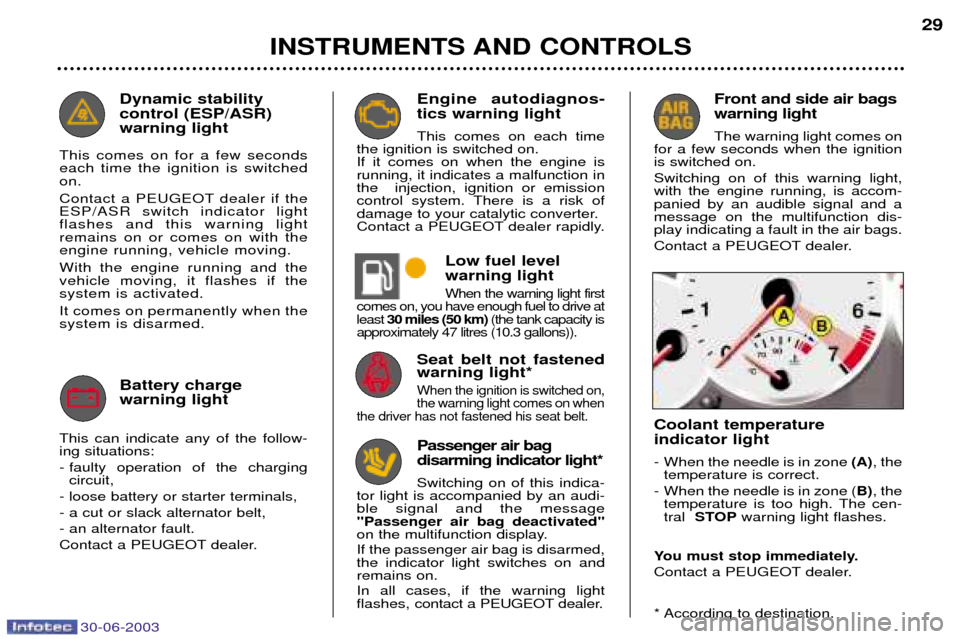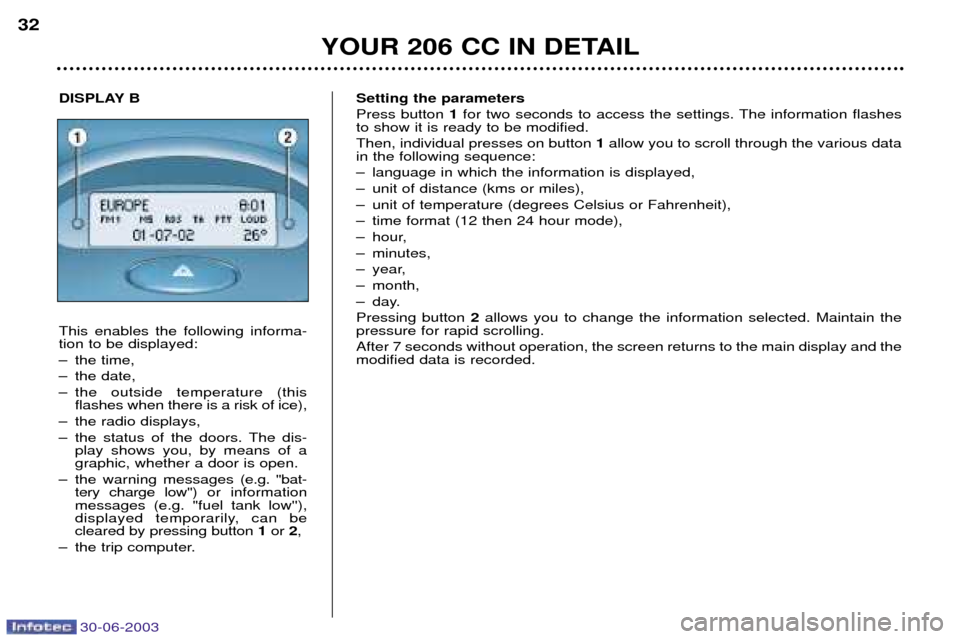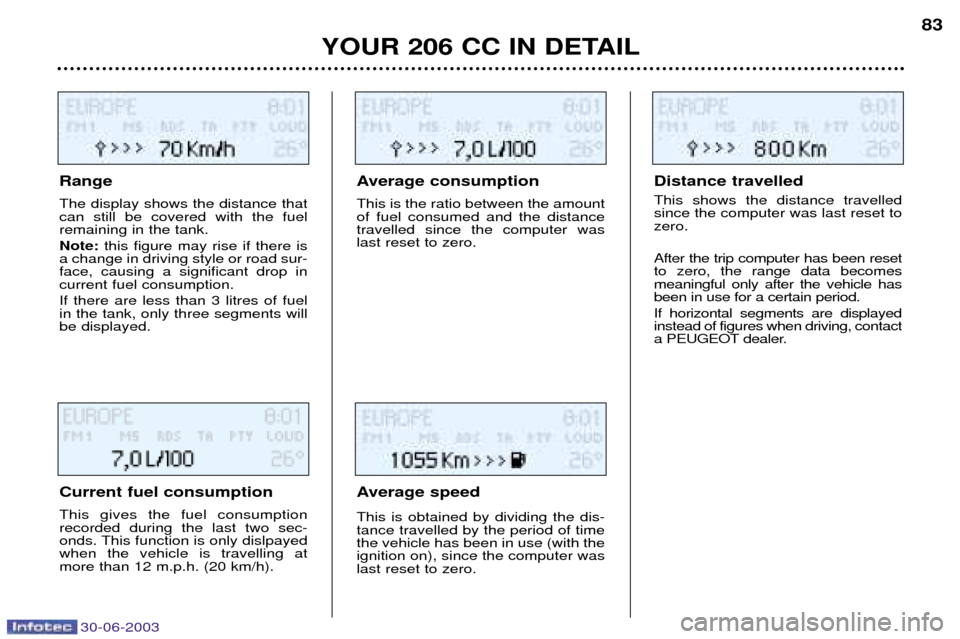Page 28 of 131

30-06-2003
INSTRUMENTS AND CONTROLS29
Front and side air bags warning light The warning light comes on
for a few seconds when the ignition is switched on. Switching on of this warning light, with the engine running, is accom-panied by an audible signal and amessage on the multifunction dis-play indicating a fault in the air bags.
Contact a PEUGEOT dealer.
Seat belt not fastened warning light*
When the ignition is switched on,the warning light comes on when
the driver has not fastened his seat belt.
Engine autodiagnos- tics warning light This comes on each time
the ignition is switched on. If it comes on when the engine isrunning, it indicates a malfunction inthe injection, ignition or emission
control system. There is a risk of
damage to your catalytic converter.
Contact a PEUGEOT dealer rapidly.
Low fuel level warning light
When the warning light first
comes on, you have enough fuel to drive at least 30 miles (50 km) (the tank capacity is
approximately 47 litres (10.3 gallons)).
Coolant temperature indicator light
- When the needle is in zone (A), the
temperature is correct.
- When the needle is in zone ( B), the
temperature is too high. The cen- tral STOP warning light flashes.
You must stop immediately.
Contact a PEUGEOT dealer.
* According to destination.
Dynamic stability control (ESP/ASR)warning light
This comes on for a few seconds each time the ignition is switchedon.
Contact a PEUGEOT dealer if the ESP/ASR switch indicator lightflashes and this warning lightremains on or comes on with theengine running, vehicle moving. With the engine running and the vehicle moving, it flashes if thesystem is activated. It comes on permanently when the system is disarmed.
Passenger air bag disarming indicator light* Switching on of this indica-
tor light is accompanied by an audi- ble signal and the message''Passenger air bag deactivated''
on the multifunction display. If the passenger air bag is disarmed, the indicator light switches on andremains on. In all cases, if the warning light flashes, contact a PEUGEOT dealer.
Battery charge warning light
This can indicate any of the follow- ing situations:
- faulty operation of the charging circuit,
- loose battery or starter terminals,- a cut or slack alternator belt,- an alternator fault.
Contact a PEUGEOT dealer.
Page 32 of 131

30-06-2003
YOUR 206 CC IN DETAIL
32Setting the parameters Press button 1for two seconds to access the settings. The information flashes
to show it is ready to be modified.Then, individual presses on button 1allow you to scroll through the various data
in the following sequence:
Ð language in which the information is displayed,
Ð unit of distance (kms or miles),
Ð unit of temperature (degrees Celsius or Fahrenheit),
Ð time format (12 then 24 hour mode),
Ð hour,
Ð minutes,
Ð year,
Ð month,
Ð day.Pressing button 2allows you to change the information selected. Maintain the
pressure for rapid scrolling.After 7 seconds without operation, the screen returns to the main display and the modified data is recorded.
DISPLAY B This enables the following informa- tion to be displayed:
Ð the time,
Ð the date,
Ð the outside temperature (this flashes when there is a risk of ice),
Ð the radio displays,
Ð the status of the doors. The dis- play shows you, by means of a graphic, whether a door is open.
Ð the warning messages (e.g. ''bat-
tery charge low'') or informationmessages (e.g. "fuel tank low''),
displayed temporarily, can becleared by pressing button 1or 2,
Ð the trip computer.
Page 33 of 131
30-06-2003
YOUR 206 CC IN DETAIL
33
DISPLAY C This enables the following informa- tion to be displayed:
Ð the time,
Ð the date,
Ð the outside temperature (thisflashes when there is a risk of ice),
Ð the radio displays,
Ð the status of the doors. The dis- play shows you, by means of a graphic, whether a door is open, Ð the warning messages are displayed temporarily (e.g. "low fuel level") and can
be cleared using the remote control,
Ð the trip computer (see corresponding section),
Ð the satellite navigation system (see corresponding section). Setting the parameters
The remote control allows you to access the settings. Accessing the different menus is described in the section "Satellite Navigation System".
Page 71 of 131

30-06-2003
YOUR 206 CC IN DETAIL
72
Changing the battery of the remote control
Warning that the battery is flat is given by an audible signal accompa-nied by the message
''Remote
control battery low'' on the multi-
function display.
To replace the battery, remove the screw then unclip the casing using acoin at the ring (CR 2016/3 volt battery). If the remote control does not work after the battery has been changed,reprogramme the remote control.
THE KEYS The keys allow you to
independent-
ly operate the locks on the doors,
the tailgate (opening), the fuel filler cap, the steering lock, the glove boxand the passenger air bag disarmingcontrol and to switch on the ignition. Central locking From the driver's door the keys allow you:
Ðto lock or unlock the doors and tail-
gate simultaneously,
Ð to unlock simultaneously just thedoors.
Unlocking the boot is possible
only by using the boot key. If one of the doors is open, the cen- tral locking does not work. The remote control This fulfils the same functions as the
key, at a distance. Locking Pressing button
Alocks the vehicle
by remote control. This is displayed by the continuouslighting of the direction indicators forapproximately two seconds. Unlocking Pressing button Bunlocks just the
doors. This is shown by the rapid flashingof the direction indicators. Notes: if the vehicle is locked and
the unlocking control is pressed inadvertently without the doorsbeing opened within 30 seconds, the
vehicle will lock again automatically.
Avoid pressing the buttons of your remote control out of range of your
vehicle. You risk causing it not towork and the remote control wouldhave to be reprogrammed.
Key in ignition
A buzzer sounds on opening the dri-
ver's door, if the key has been left inthe ignition. Locating your car
To locate your car in a car park, if you have locked it: �
press button A, the courtesy light
comes on and the direction indi- cators flash for a few seconds.Programming the remote control � Switch off the ignition.
� Switch the ignition on again.
� Press button Aimmediately.
� Switch off the ignition and remove the remote control key from the
ignition lock. The remote control isnow working again.
Page 75 of 131
30-06-2003
YOUR 206 CC IN DETAIL75
BONNET STRUT Secure the strut to hold the bonnet open. Before closing the bonnet, replace the strut in its housing.
To close Lower the bonnet and release it at the end of its travel. Check that thebonnet is locked.
OPENING THE BONNET Inside the vehicle:
pull the handle
on the left-hand side, under the fascia. Outside the vehicle: lift the catch
and raise the bonnet. FILLING THE FUEL TANK The tank must be filled with fuel with the engine switched off
.
Insert the key then turn it to the left. Remove the cap.
A label indicates which type of fuel to use. If you fill your tank, do not continue
after the third cut-off of the pump
nozzle. This could result in vehiclemalfunctions. The capacity of the tank is approximately 10.3 gallons (47 litres).
Page 84 of 131

30-06-2003
YOUR 206 CC IN DETAIL83
Range The display shows the distance that can still be covered with the fuelremaining in the tank. Note:
this figure may rise if there is
a change in driving style or road sur- face, causing a significant drop incurrent fuel consumption. If there are less than 3 litres of fuel in the tank, only three segments willbe displayed.
Current fuel consumption This gives the fuel consumption recorded during the last two sec-
onds. This function is only dislpayedwhen the vehicle is travelling atmore than 12 m.p.h. (20 km/h).
Average consumption This is the ratio between the amount of fuel consumed and the distancetravelled since the computer waslast reset to zero.
Average speed This is obtained by dividing the dis- tance travelled by the period of timethe vehicle has been in use (with theignition on), since the computer waslast reset to zero. Distance travelled This shows the distance travelled since the computer was last reset tozero. After the trip computer has been reset to zero, the range data becomesmeaningful only after the vehicle hasbeen in use for a certain period. If horizontal segments are displayed instead of figures when driving, contact
a PEUGEOT dealer.
Page 115 of 131
30-06-2003
PRACTICAL INFORMATION111
Fuse Rating
Functions
1 10 A Reversing lights switch - Speed sensor
2 15 A Canister solenoid valve - Fuel pump
3 10 A ABS/ESP engine control unit - ESP stop switch
4 10 A Automatic gearbox control unit - Engine control unit
5 Ð Not used
6 15 A Front fog lamps
7 20 A Windscreen wash pump
8 20 A Fan unit relay - Engine control unit - Engine management solenoid valve
9 15 A Left-hand dipped beam
10 15 A Right-hand dipped beam
11 10 A Left-hand main beam
12 15 A Right-hand main beam
13 15 A Horns
14 10 A Front windscreen wash pump
15 30 A Throttle unit heater - Oxygen sensor - Engine control unit - Ignition coil -
Engine management solenoid valve - Injectors
16 30 A Air pump relay
17 30 A High and low speed windscreen wiper
18 40 A Air conditioning fan
Page 128 of 131
30-06-2003
TECHNICAL DATA
124
ENGINES AND GEARBOXES
MODELS Model codes 2DNFUF 2DNFUR 2DRFNF
ENGINES 1.6 litre 16V 2 litres 16V
Cubic capacity (cm 3
) 1 587 1 997
Bore x stroke (mm) 78.5 x 82 85 x 88
EU standard maximum power (kW) 80 100
Maximum power at engine speed (rpm) 5 800 6 000
EU standard maximum torque (Nm) 147 190
Maximum torque at engine speed (rpm) 4 000 4 100 Fuel Unleaded Unleaded
Catalytic converter Yes Yes
Gearbox Manual Automatic Manual
(5 speed) (4 speed) (5 speed)
Unit capacities (in litres)
Engine (with cartridge replacement) 3 3 4.25Gearbox-Final drive 2 Ð 1.9